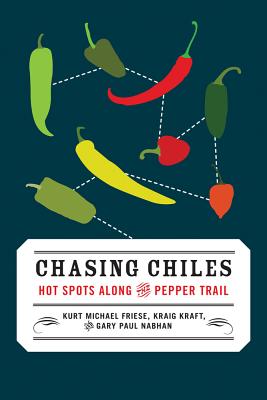

 Chelsea Green Publishing Company
Chelsea Green Publishing Company
Chasing Chiles: Hot Spots Along the Pepper Trail


Key Metrics
- Gary Paul Nabhan
- Chelsea Green Publishing Company
- Paperback
- 9781603582506
- 8.97 X 6.01 X 0.59 inches
- 0.78 pounds
- Cooking > Essays & Narratives
- English
 Secure Transaction
Secure TransactionBook Description
Chasing Chiles looks at both the future of place-based foods and the effects of climate change on agriculture through the lens of the chile pepper-from the farmers who cultivate this iconic crop to the cuisines and cultural traditions in which peppers play a huge role.
Why chile peppers? Both a spice and a vegetable, chile peppers have captivated imaginations and taste buds for thousands of years. Native to Mesoamerica and the New World, chiles are currently grown on every continent, since their relatively recent introduction to Europe (in the early 1500s via Christopher Columbus). Chiles are delicious, dynamic, and very diverse-they have been rapidly adopted, adapted, and assimilated into numerous world cuisines, and while malleable to a degree, certain heirloom varieties are deeply tied to place and culture-but now accelerating climate change may be scrambling their terroir.
Over a year-long journey, three pepper-loving gastronauts-an agroecologist, a chef, and an ethnobotanist-set out to find the real stories of America's rarest heirloom chile varieties, and learn about the changing climate from farmers and other people who live by the pepper, and who, lately, have been adapting to shifting growing conditions and weather patterns. They put a face on an issue that has been made far too abstract for our own good.
Chasing Chiles is not your archetypal book about climate change, with facts and computer models delivered by a distant narrator. On the contrary, these three dedicated chileheads look and listen, sit down to eat, and get stories and recipes from on the ground-in farmers' fields, local cafes, and the desert-scrub hillsides across North America. From the Sonoran Desert to Santa Fe and St. Augustine (the two oldest cities in the U.S.), from the marshes of Avery Island in Cajun Louisiana to the thin limestone soils of the Yucatan, this book looks at how and why climate change will continue to affect our palates and our producers, and how it already has.
Author Bio
Gary Nabhan, Ph.D., W.K. Kellogg Chair in Southwest Borderlands Food and Water Security, is an ethnobiologist, agroecologist, conservation biologist and cultural geographer trained at the University of Arizona and Prescott College.
He is author or editor of 26 books translated into 6 languages, a number of which have won awards. In addition to his research, teaching and community service on sustainable food systems, Nabhan farms during the summer in Patagonia, Arizona. Political Ecology of Food, Conservation Ranching and Ecosystem Services, Traditional Ecological Knowledge, Sustainable Food Systems, and Science Writing.
Current Projects: Tumamoc Hill phenology change; Sonoran Desert oasis initiative (with Susie and Paul Fish); Sabores Sin Fronteras Foodways Alliance; Stitching the West Back Together working landscapes initiative (with Tom Sheridan and Susan Charnley); biodiversity of desert oases (with Rafael Routson and Amadeo Rea); Renewing America's Food Traditions agrobiodiversity inventory (with Collaborative, American Livestock Breeds Conservancy and Western Folklife Center); climate change adaptation and agrobiodiversity (with the University of Arizona Institute for the Environment).
Source: The University of Arizona
Videos












Community reviews
Write a ReviewNo Community reviews